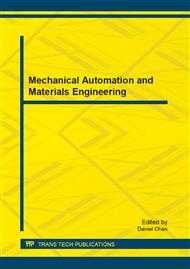p.324
p.329
p.333
p.341
p.346
p.352
p.357
p.361
p.365
Numerical Simulation of Bionic Locomotor Batoid with Combined Frequency Undulating Pectoral Fins
Abstract:
Batoids propel themselves forward by generating waves along their large pectoral fins. According to the observation of batoids in nature, the frequency of the wave on the pectoral fins is not always invariable. The bionic batoid is composed of rigid body and flexible pectoral fins of uniform thickness. In this study the hydrodynamic analysis of bionic batoid with combined frequency specified on the pectoral fins are presented. The combined frequency is implemented by the frequency conversion during the oscillation of each pectoral fin ray. Since oscillating frequency of 2.2Hz is mostly observed in rajiform batoid, the variable frequencies ranging from 1.0Hz to 2.6Hz with 0.4Hz increment compound 2.2Hz and formed five different sets of combined frequency. The simulation results illustrate that the bionic batoid model with combined frequency locomotion can achieve better propulsive efficiency, which maybe benefit for the motion design of bionic robot batoid.
Info:
Periodical:
Pages:
346-351
Citation:
Online since:
August 2013
Authors:
Keywords:
Price:
Сopyright:
© 2013 Trans Tech Publications Ltd. All Rights Reserved
Share:
Citation:


